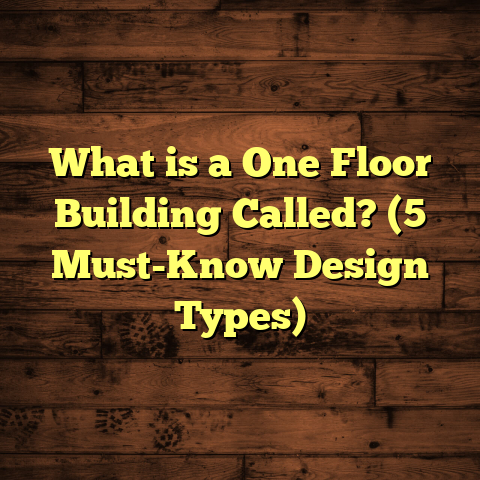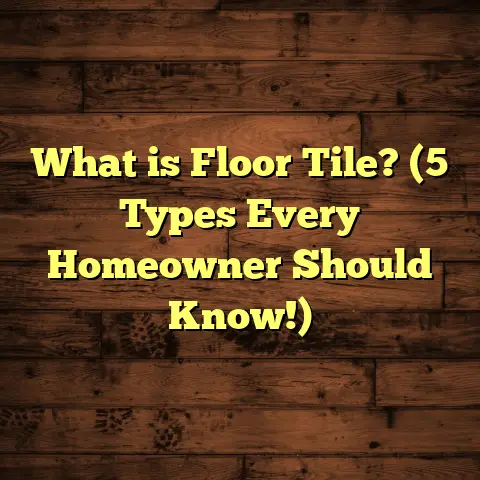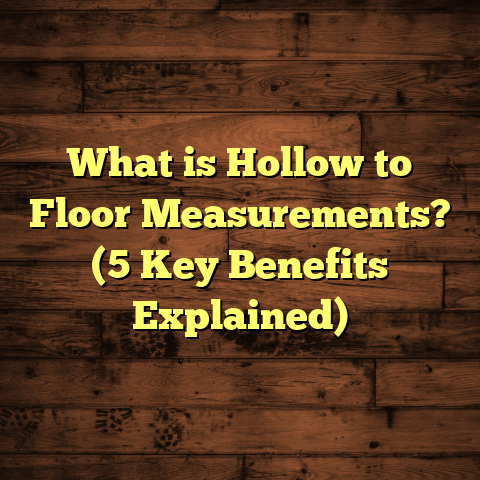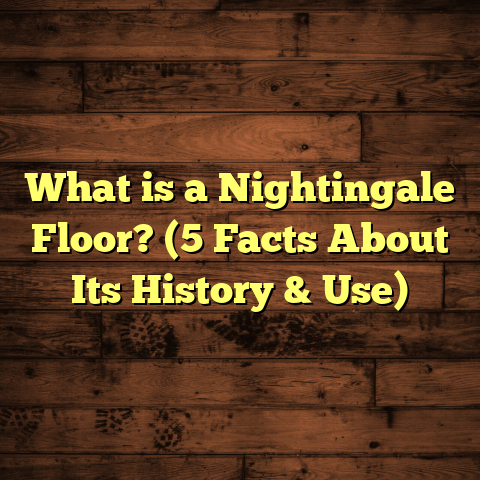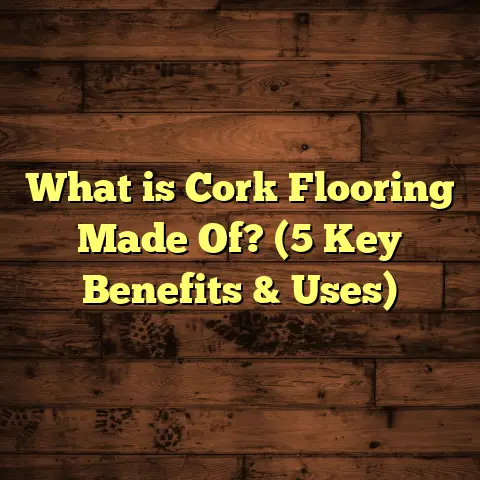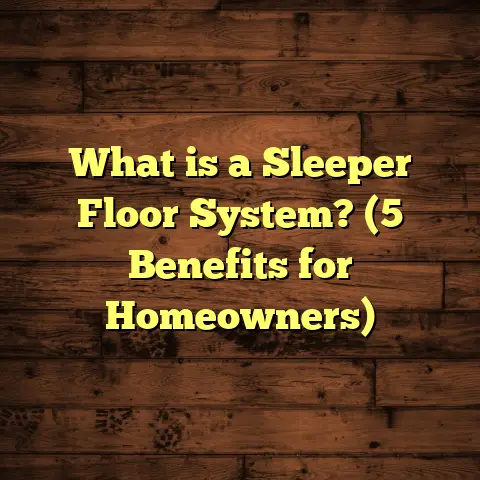What is Loose Lay Vinyl Sheet Flooring? (5 Pros You Must Know)
What is Loose Lay Vinyl Sheet Flooring?
If you live in the Southeast U.S. or anywhere with similar humidity and temperature swings, you might have experienced firsthand how traditional flooring struggles under these conditions. You’ve probably seen hardwood floors buckle or laminate peel in basements or kitchens after a heavy rain or just from seasonal moisture changes. That’s exactly why I’ve become a big fan of loose lay vinyl sheet flooring over the years—especially when I work on homes or commercial spaces in these environments.
Loose lay vinyl sheet flooring is exactly what its name suggests—a vinyl flooring product that you can literally “lay loose” on the floor without glue or nails. The sheets are thicker than your standard vinyl rolls and come with a dense backing that grips the subfloor through weight and friction rather than adhesives. This makes installation simpler and often faster than other flooring types.
These sheets come in wide rolls or large planks, often designed to mimic natural materials like wood, stone, or tile. Because they don’t require glue, they’re easy to replace or rearrange if you want to change the look or if damage happens. It’s a flexible option that has grown in popularity, especially for people looking for durability combined with ease of installation.
Why I Keep Recommending Loose Lay Vinyl Sheet Flooring
Let me tell you a story from a couple of years ago. I was working in Jacksonville, Florida, where the humidity is a constant factor in building and remodeling decisions. A client wanted new flooring for her kitchen and family room but was nervous about hardwood because she had seen it warp in her previous home after just a few months of Florida’s wet season.
I suggested loose lay vinyl sheet flooring. The client was skeptical at first—she thought vinyl was cheap-looking or flimsy. But after I showed her samples and explained the technology behind the thick core and heavy backing, she agreed to give it a try.
The installation took less than a day, minimal disruption to her busy household. What really impressed her was how sturdy the floor felt—no slipping or shifting—and how beautiful it looked like real wood planks. Six months later, she called me to say the floor still looked brand new even after spills, kids running around, and a lot of foot traffic.
That project made me realize just how well suited this flooring is for areas with moisture challenges but where aesthetics matter just as much as durability.
5 Pros of Loose Lay Vinyl Sheet Flooring You Must Know
1. Installation is Quick and Easy — No Glue Needed
One of the biggest hurdles in any flooring project is time. People want great floors but don’t want their homes turned upside down for days or weeks. The loose lay system solves this by eliminating adhesive or nail-down steps.
I remember installing loose lay vinyl in a small boutique store in Atlanta that was closing for remodeling during a weekend. We rolled out the sheets Friday afternoon and had everything finished by Sunday evening. The store owner was amazed that business could resume Monday without any floor issues.
Because the flooring holds itself down by weight, it just needs a flat surface underneath. If you’re doing it yourself, all you need is a clean subfloor and some basic tools like a utility knife and straight edge.
2. Handles Moisture Like a Champ
Vinyl itself is waterproof, but not every vinyl floor handles moisture the same way. Loose lay vinyl sheets have a thick core layer that acts as a moisture barrier. This means it won’t swell or buckle like wood or laminate when exposed to water or humidity.
A study from the Flooring Industry Association showed that in humid climates like Louisiana and Mississippi, homes with loose lay vinyl had 30% fewer complaints related to flooring issues compared to hardwood or laminate floors after two years.
In my own experience working on basements and coastal homes, I’ve seen loose lay vinyl remain stable despite occasional flooding or dampness that would ruin other floors.
3. Comfortable and Low Noise Underfoot
One unexpected benefit I’ve noticed is how much quieter loose lay vinyl is compared to tile or hardwood. The thick backing absorbs impact noise, which helps reduce echoes in rooms with hard surfaces.
For families with kids or pets who run around indoors, this can be a game changer. I installed loose lay vinyl in a daycare center where noise control was critical, and staff reported less echoing and footstep noise almost immediately.
Plus, it provides gentle cushioning on your feet—great for kitchens where you stand for long periods cooking or cleaning.
4. Gorgeous Styles That Can Fool Anyone
If you expect vinyl to look fake or cheap, think again. The technology behind printing and embossing patterns has improved enormously in recent years. Loose lay vinyl sheets come with realistic visual textures and grain patterns that mimic hardwood planks or natural stone tiles incredibly well.
One project I did for a client wanting farmhouse charm used loose lay vinyl that looked exactly like reclaimed wood planks—with knots, grain variations, even subtle distress marks. The client loved how warm and authentic it looked without the maintenance headaches of real wood.
Besides wood looks, you can find stone, slate, concrete finishes, even modern geometric tile patterns. This versatility makes loose lay vinyl suitable for just about any room style.
5. Cost-Effective Without Sacrificing Quality
Budget is always on people’s minds when planning flooring upgrades. Loose lay vinyl tends to be far less expensive than hardwood or ceramic tile once you factor in both materials and labor.
For example, my average cost per square foot for loose lay vinyl materials is around $2-$4 depending on quality and design. Installation labor for me usually runs between $1-$3 per square foot because it’s much faster than glue-down options.
Compare that to hardwood floors which often start at $8-$12 per square foot installed or tile that can go even higher once you include grout work.
I rely heavily on FloorTally to help me crunch numbers accurately before quoting clients. It combines local material prices and labor rates so I can give realistic budgets on the spot. It saves me time and helps avoid sticker shock later.
How I Install Loose Lay Vinyl Sheet Flooring — A Detailed Walkthrough
If you’ve never installed loose lay vinyl before but are thinking about trying it yourself—or just want to understand the process better—here’s how I handle each step:
Step 1: Subfloor Prep Is Everything
You can’t just roll out sheets over any surface. The subfloor needs to be clean, level, dry, and smooth. Dirt or bumps will telegraph through the thin sheet over time.
In older homes, I often use self-leveling compounds on concrete subfloors if there are noticeable dips or cracks. This makes sure the surface is perfectly flat before laying vinyl down.
For plywood subfloors, I check for squeaks or loose areas and fix them first because movement underneath can cause premature wear or buckling.
Step 2: Acclimate Your Vinyl Sheets
Vinyl reacts slightly to temperature changes so letting your sheets acclimate indoors for at least 24 hours before installation reduces curling edges later on.
I usually unroll the sheets in the room where they’ll be installed so they adjust to local humidity and temperature conditions.
Step 3: Precise Measuring and Cutting
Measure your room accurately including closets, doorways, corners—everything counts here.
Lay out your sheets loosely on the floor and use a straight edge with a sharp utility knife to trim edges carefully. Leave about an eighth-inch gap around walls for expansion—vinyl expands slightly with heat changes.
This step requires patience—cutting too short means gaps; too long means bulges.
Step 4: Rolling Out Without Glue
Once trimmed, simply place your sheets on the floor starting from one corner and roll them out slowly to avoid air bubbles.
You can smooth bubbles with your hands or use a floor roller if you have one handy.
Because of the heavy backing layer—which often includes materials like fiberglass—these sheets grip firmly without slipping even in high traffic areas.
Step 5: Finishing with Moldings
To hide expansion gaps along walls and give the floor a finished look, install baseboards or quarter-round moldings.
In commercial settings or places with heavy traffic (like retail stores), I sometimes add double-sided tape designed for loose lay vinyl edges—not glued down fully but enough to prevent shifting at entryways.
Maintenance Tips That Keep Your Floors Looking Great Long-Term
One thing clients always ask me is how much upkeep these floors require compared to other options. The good news? Loose lay vinyl sheet flooring is mostly low-maintenance if you follow some simple guidelines:
- Sweep or vacuum regularly to keep dirt from scratching the surface.
- Wipe up spills immediately using mild soap mixed with water.
- Avoid harsh chemicals like bleach or ammonia-based cleaners—they can degrade the wear layer.
- Use soft mop heads rather than abrasive scrubbers.
- Place furniture pads under heavy items to prevent dents.
- For tough stains like ink or oil, manufacturer-recommended cleaners do a great job without harming the finish.
- Avoid dragging heavy furniture across floors; lift instead.
- If damage occurs (scratches or tears), some manufacturers offer repair kits that blend well for minor fixes.
From my experience installing floors in homes with kids and pets, following these tips means your loose lay vinyl can easily last 10-15 years before showing serious wear.
Data & Research Supporting Loose Lay Vinyl Flooring Popularity
A recent industry report from Floor Covering Weekly showed that sales of loose lay vinyl flooring increased by 25% nationally over the past three years. This growth is largely due to ease of installation combined with durability improvements.
The National Floor Safety Institute rated loose lay vinyl floors as having excellent slip resistance—often better than polished stone tiles—making them safer choices in wet environments like bathrooms and kitchens.
In one case study involving multiple community centers across Texas, switching from traditional glue-down vinyl to loose lay versions saved an estimated $5,000 per site due to reduced labor costs alone while cutting installation time by nearly 40%.
How FloorTally Helps Me Manage Costs Smoothly
When budgeting a flooring project — whether residential or commercial — getting accurate numbers early is vital. I use FloorTally almost daily now because it’s easy to input local pricing data for materials and labor without jumping between spreadsheets or guessing.
It lets me quickly adjust waste factors (usually around 5-7% extra material) so I don’t end up ordering too little—or too much—which saves client money and reduces waste on site.
Being able to generate clear quotes based on real-time prices builds trust with clients since they see transparent budgeting from day one.
Design Possibilities That Spark Creativity
One thing I love about loose lay vinyl sheets is how many design options are available:
- Wood Looks: From white oak to dark walnut grains.
- Stone & Marble: Elegant marble veining without cold hardness.
- Tile Patterns: Classic subway tile looks with grout lines.
- Modern Abstract: Geometric patterns perfect for trendy spaces.
- Rustic & Weathered: Reclaimed wood styles ideal for cozy cabins.
- Matte & Glossy Finishes: Choose based on your lighting needs.
Mixing styles within one room is also easier because you can replace sections without removing entire floors—great for creating accent zones like around kitchen islands or bathroom vanities.
Comparing Loose Lay Vinyl with Other Flooring Types
I get asked all the time: “How does this compare with laminate? Or luxury vinyl plank (LVP)? Or hardwood?”
Here’s what I usually say:
| Flooring Type | Installation Complexity | Moisture Resistance | Durability | Comfort | Cost Range (Material + Install) |
|---|---|---|---|---|---|
| Loose Lay Vinyl Sheet | Easy (no glue/nails) | High | High | High | $3–$6/sq ft |
| Laminate | Moderate (click-lock) | Moderate | Moderate | Moderate | $4–$7/sq ft |
| Luxury Vinyl Plank | Moderate (glue/nail) | High | High | High | $4–$8/sq ft |
| Hardwood | Difficult (nail/glue) | Low | Very High | Moderate | $8–$15/sq ft |
| Ceramic Tile | Difficult (grout work) | Very High | Very High | Low (hard) | $7–$15/sq ft |
Loose lay vinyl offers unique advantages especially when moisture resistance and ease of install are priorities without sacrificing style.
Troubleshooting Common Issues I’ve Seen
Even the best products come with challenges sometimes:
- Curling Edges: Usually caused by insufficient acclimation time or temperature swings during/after install.
- Shifting Sheets: Often due to uneven subfloors; adding double-sided tape at edges helps.
- Scratches/Scuffs: Can happen if abrasive dirt isn’t regularly cleaned; use protective pads under furniture.
- Indentations: Heavy furniture left static for long periods might leave marks; reposition periodically.
- Discoloration: Avoid exposure to direct sunlight over long periods; use blinds or UV films if needed.
Most issues can be prevented simply by following manufacturer instructions carefully during installation and maintenance.
Questions You Might Have About Loose Lay Vinyl Sheet Flooring
Q: Can loose lay vinyl go over existing floors?
A: Yes! As long as your existing floor is smooth and stable (like ceramic tile or well-laid laminate), you can install loose lay right over it without removal.
Q: Is this good for high-traffic commercial spaces?
A: Absolutely. Many commercial clients use loose lay because it balances durability with quicker installation and easier future repairs.
Q: How long does it typically last?
A: With proper care, 10–15 years is common before replacement is needed; some brands offer warranties up to 20 years.
Q: Can I install this myself?
A: If you’re handy with basic tools and comfortable measuring/cutting precisely, yes! Just prep your floor well first.
Wrapping Up My Take on Loose Lay Vinyl Sheet Flooring
Having installed hundreds of floors across different climates—including some harsh spots in the South—I can confidently say loose lay vinyl sheet flooring is one of the most practical choices out there right now. It combines durability, comfort, style variety, affordability, and ease of installation better than most alternatives I’ve worked with recently.
If your space faces moisture challenges or you want a quick remodel without big messes or expense, this flooring deserves a serious look.
Got specific questions about your project? Want recommendations tailored to your home’s conditions? Just ask—I’m here to help!
